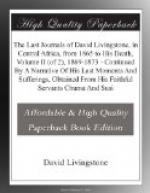[Illustration: Catching Ants.]
24th-25th October, 1869.—Making copper rings, as these are highly prized by Manyuema. Mohamad’s Tembe fell. It had been begun on an unlucky day, the 26th of the moon; and on another occasion on the same day, he had fifty slaves swept away by a sudden flood of a dry river in the Obena country: they are great observers of lucky and unlucky days.
FOOTNOTES:
[1] On showing Chuma and Susi some immense Cochin-China fowls at a poultry show, they said that they were not larger than those which they saw when with Dr. Livingstone on these islands. Muscovy ducks abound throughout Central Africa.—ED.
[2] The natural dress of the Malagash.
[3] The same as Unyanyembe, the half-way settlement on the great caravan road from the coast to the interior.
[4] These letters must have been destroyed purposely by the Arabs, for they never arrived at Zanzibar.—ED.
[5] It is curious that this name occurs amongst the Zulu tribes south of the Zambesi, and, as it has no vowel at the end, appears to be of altogether foreign origin.—ED.
[6] In 1859.
CHAPTER II.
Prepares to explore River Lualaba. Beauty of the Manyuema country. Irritation at conduct of Arabs. Dugumbe’s ravages. Hordes of traders arrive. Severe fever. Elephant trap. Sickness in camp. A good Samaritan. Reaches Mamohela and is prostrated. Beneficial effects of Nyumbo plant. Long illness. An elephant of three tusks. All men desert except Susi, Chuma, and Gardner. Starts with these to Lualaba. Arab assassinated by outraged Manyuema. Returns baffled to Mamohela. Long and dreadful suffering from ulcerated feet. Questionable cannibalism. Hears of four river sources close together. Resume of discoveries. Contemporary explorers. The soko. Description of its habits. Dr. Livingstone feels himself failing. Intrigues of deserters.
1st November, 1869.—Being now well rested, I resolved to go west to Lualaba and buy a canoe for its exploration. Our course was west and south-west, through a country surpassingly beautiful, mountainous, and villages perched on the talus of each great mass for the sake of quick drainage. The streets often run east and west, in order that the bright blazing sun may lick up the moisture quickly from off them. The dwelling houses are generally in line, with public meeting houses at each end, opposite the middle of the street, the roofs are low, but well thatched with a leaf resembling the banana leaf, but more tough; it seems from its fruit to be a species of Euphorbia. The leaf-stack has a notch made in it of two or three inches lengthways, and this hooks on to the rafters, which are often of the leaf-stalks of palms, split up so as to be thin; the water runs quickly off this roof, and the walls, which are of well-beaten clay, are screened from the weather. Inside, the dwellings are clean and comfortable, and before the Arabs came bugs were unknown—as I have before observed, one may know where these people have come by the presence or absence of these nasty vermin: the human tick, which infests all Arab and Suaheli houses, is to the Manyuema unknown.




